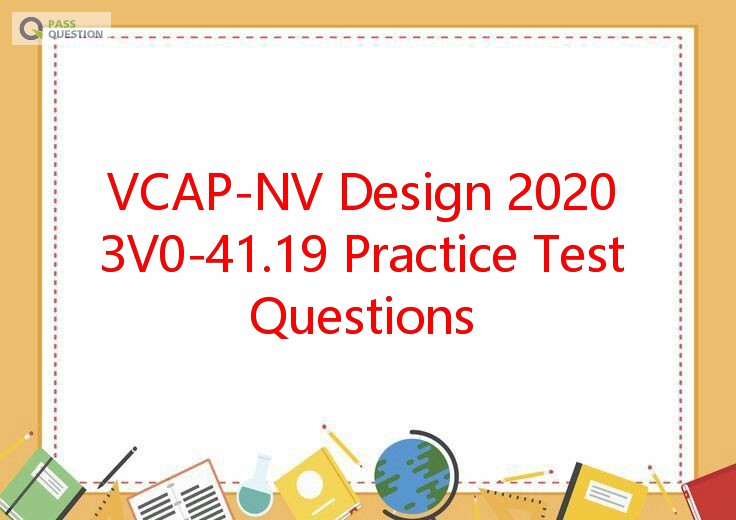VCAP-NV Design 2020 3V0-41.19 Practice Test Questions
How to prepare for 3V0-41.19 Advanced Design NSX-T Data Center 2.4 Exam well? It is highly recommended to choose PassQuestion VCAP-NV Design 2020 3V0-41.19 Practice Test Questions to prepare for 3V0-41.19 exam well. New 3V0-41.19 questions and answers were released which is the latest study guide for passing VMware 3V0-41.19 Exam. If you choose PassQuestion VCAP-NV Design 2020 3V0-41.19 Practice Test Questions, we ensure you can pass VMware 3V0-41.19 exam in the first try.

3V0-41.19 Exam Details - Advanced Design NSX-T Data Center 2.4
The Advanced Design NSX-T Data Center 2.4 exam (3V0-41.19) which leads to VMware Certified Advanced Professional – Network Virtualization 2020 certification is a 50-item exam, with a passing score of 300 using a scaled method. Candidates are given an appointment time of 105 minutes, which includes five-minute seating time and adequate time to complete the exam for non-native English speakers. Actual exam time is 100 minutes.
3V0-41.19 Exam Topics Covered In Real Test
Section 1 – Architecture and Technologies
Section 2 – Products and Solutions
Section 3 – Planning and Designing
Section 4 – Installing, Configuring, and Setup
Section 5 – Performance-tuning, Optimization, and Upgrades
Section 6 – Troubleshooting and Repairing
Section 7 – Administrative and Operational Tasks
View Online Advanced Design NSX-T Data Center 2.4 3V0-41.19 Free Questions
1.Which NSX-T feature is used to allocate the network bandwidth to business-critical applications and to resolve situations where several types of traffic compete for common resources?
A. LAG Uplink Profile
B. Transport Node Profiles
C. LLDP Profile
D. Network I/O Control Profiles
Answer: D
2.An architect is helping an organization with the Physical Design of an NSX-T Data Center solution and resolving a network throughput bottleneck.
This information was gathered during a workshop:
- A VM running a business critical application Is peaking at ~5Gbps
- Current host uplink is configured as Active/Standby with two 10Gb NICs.
- The installed server NIC model does not support GENEVE offload.
- All VM traffic is East/West.
- The business critical application VM communicates with multiple client VMs.
Which should the architect recommend to improve vSphere VM throughput?
A. Configure the Transport Node Uplink Profile to use a Load Balance Source teaming policy with two active uplinks.
B. Deploy an additional Edge Node to the Edge Node Cluster.
C. Replace the existing network switches and routers with newer higher-performance.
D. Replace the existing NICs with a model that supports GENEVE offload.
Answer: D
3.Which three must be taken into consideration when creating a Logical Design for a planned migration? (Choose three.)
A. A transport node can attach single VLAN transport zones with single N-VDS.
B. An N-VDS with the same name can be attached to both Overlay and VLAN transport zones.
C. An N-VDS can attach to both an Overlay and a VLAN transport zone to a N-VDS having different name/s.
D. An N-VDS can only attach to a single Overlay transport zone.
E. An N-VDS can only attach to a single VLAN transport zone.
F. An N-VDS can only attach to a multiple VLAN transport nodes.
Answer: B,D,F
4.An architect is helping an organization with the Logical Design of an NSX-T Data Center solution.
This information was gathered during the Assessment Phase:
- Maximum performance and availability is required between the physical and virtual network.
- Load Balancing service is required for back-end web servers.
- NAT is required.
Which should the architect include in their design?
A. Deploy a Tler-1 gateway and connect It to an Active/Active Tier-0 gateway with ECMP configured.
B. Deploy an Active/Active Tier-0 gateway and configure ECMP.
C. Create two separate VLANs to connect the Tier-0 gateway upstream traffic and configure ECMP.
D. Deploy an Active/Passive Tier-0 gateway and configure ECMP.
Answer: A
5.Which is associated with the Discover Task of the Engagement Lifecycle?
A. Create and document the logical and virtual design.
B. Gather and document requirements, assumptions and constraints.
C. Build, deploy, implement and test the design.
D. Measure performance against customer's requirements.
Answer: B
6.An NSX-T architect is working with a customer who wants to improve performance and future-proof their workloads with a multi-site architecture.
A current-state analysis captured this information:
- Latency between sites Is 160ms.
- Bandwidth is 2Gbps.
- The MTU is 1600.
What two VMware design recommendations should the architect recommend to the organization to achieve future-proofing? (Choose two.)
A. Latency must be less than 150ms.
B. Bandwidth must be at least 10Gbps.
C. MTU is recommended to be 9000.
D. MTU must be at least 1700.
E. Latency RTT is acceptable.
Answer: A,C
- TOP 50 Exam Questions
-
Exam
All copyrights reserved 2025 PassQuestion NETWORK CO.,LIMITED. All Rights Reserved.

